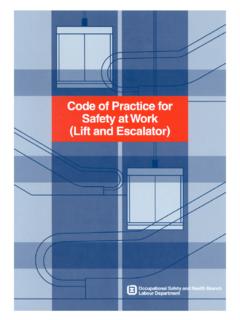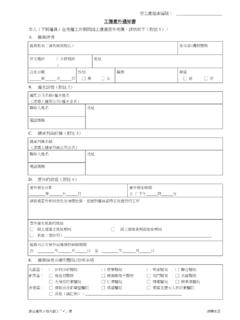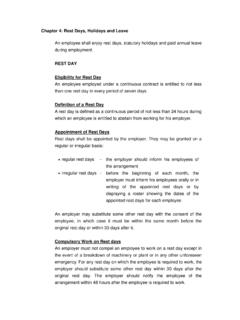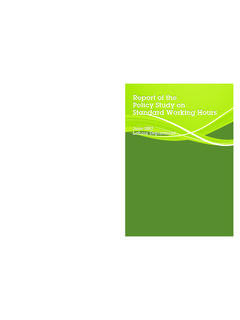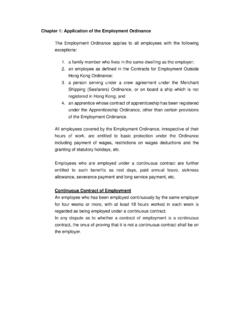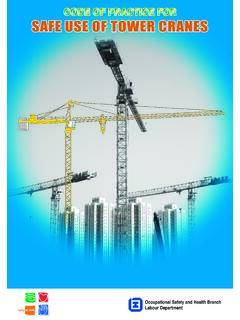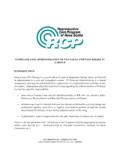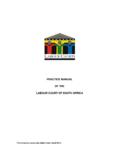Transcription of Code of Practice in Times of Typhoons and Rainstorms - …
1 1 Table of ContentsIntroduction 2 Key points of work arrangements in Times of Typhoons 3and rainstormsChapter One Work arrangements in Times of 5 Typhoons and rainstormsChapter Two Rules regarding report for duty 7 Chapter Three Rules regarding release from work 10 Chapter Four Rules regarding resumption of work 12 Chapter Five Payment of wages and allowances 13 Chapter Six Provisions under the Employment 15 OrdinanceChapter Seven Provisions under the Occupational 16 Safety and Health OrdinanceChapter Eight Provisions under the Employees 17 Compensation OrdinanceAppendix 1 Work arrangements in Times of 18 Typhoons and Rainstorms (Sample)Appendix 2 Work arrangements for work outdoor and 26 in exposed areas in Times of inclement weather conditions, Typhoons and Rainstorms (Sample)Appendix 3 Weather warnings 39 Appendix 4 Enquiries 432 IntroductionHong Kong is frequented by tropical cyclones (commonly known as Typhoons ) and Rainstorms during the summer months.
2 It is essential that employers and employees should take prompt and necessary action to ensure that practical and reasonable work arrangements are in place. This would help prevent unnecessary disputes and confusion, maintain good labour -management relations, and ensure safety of employees and the smooth operation of the the diversity in nature and requirements of different jobs in various trades and industries, and the need for some essential services, like public transport, public utilities, medical services, hotels and security etc., to maintain normal operation under inclement weather conditions, it would not be practicable to introduce legislation governing work arrangements for employees when a Tropical Cyclone Warning Signal ( Typhoon Warning Signal ) or a Rainstorm Warning is in force. However, the labour Department attaches great importance to the safety of employees in their workplaces as well as on their journey to and from work.
3 We also concern about the possible inconvenience and difficulties brought to the public and certain industries if some services are suspended. Taking into account the extensive interests of employers, employees and the community, this booklet seeks to provide advice and practical guidelines on work arrangements in Times of Typhoons and Rainstorms . Although this booklet is not part of legislation, employers are advised to make reference to the guidelines and adopt a flexible approach in preparing suitable work stand ready to provide any assistance you may need in respect of the work arrangements. If necessary, please contact us through: Enquiry Hotline: 2717 1771 (the hotline is handled by 1823 ) labour Department s Homepage: Offices of the labour Relations Division (please see Appendix 4 for their addresses)(This booklet has also been uploaded to the labour Department s Homepage.)
4 3 Key points of work arrangements in Times of Typhoons and rainstormsWhat employers should do? Take prime consideration of employees safety in the workplace and during the journey to and from work. Observe the statutory liabilities and requirements under the Occupational Safety and Health Ordinance, the Employees Compensation Ordinance, the Employment Ordinance and the Minimum Wage Ordinance. Consult and involve employees in working out prior work arrangements and contingency measures. Make realistic and critical assessment of staff requirements and only require those staff who are absolutely essential to report for duty when Typhoon Warning Signal No. 8 or above or Black Rainstorm Warning is in force. State clearly the time of issuance and cancellation of the Typhoon Warning Signals or Rainstorm Warnings at which employees are not required to report for duty or have to resume work.
5 Provide employees with adequate facilities and equipment such as safety helmets and raincoats to ensure their safety at work. If at all possible, provide transport services for employees who are required to travel to and from their workplaces when Typhoon Warning Signal No. 8 or above or Black Rainstorm Warning is in force and pay particular attention to their safety. If such arrangement is not feasible, a special travelling allowance should be considered. Be flexible in handling cases of employees failing to report for duty or resume work on time due to genuine difficulties. Do not deduct wages of employees who are absent from or late for work due to adverse weather conditions or other factors beyond their Set down clear guidelines on calculation of working hours, payment of wages and allowances under different situations.
6 Consider giving typhoon or rainstorm allowances as an encouragement to employees who have worked in Times of Typhoons and Rainstorms . Release employees from work in stages as soon as practicable after the Pre-No. 8 Special Announcement is issued as weather conditions will employees should do? As a general Practice , provided that public transport services are available, employees are usually required to work when Typhoon Warning Signal No. 3 or below is issued or when Amber or Red Rainstorm Warning is in force. Report for duty on time in accordance with the prior work arrangement. In case of genuine difficulties, notify the supervisors as soon as practicable. Unless there are prior work arrangements to the contrary, employees are normally expected to resume work after Typhoon Warning Signal No.
7 8 or Black Rainstorm Warning has been cancelled. Co-operate with the employer and follow the safety rules and work procedures. 51 Work arrangements in Times of Typhoons and rainstormsGeneral aspectsIn Hong Kong, Typhoons and Rainstorms normally occur during the summer months. In Times of Typhoons , the Hong Kong Observatory issues Typhoon Warning Signals according to the level of threat. It normally issues an early alert ( Pre-No. 8 Special Announcement ) once the Typhoon Warning Signal No. 8 is expected to be issued within two hours to allow employers sufficient time to release their employees in stages according to the operational requirements of individual industry/organisation so as to ensure the safety of employees and ease traffic congestion. The Rainstorm Warning System aims to alert the public of the occurrence of heavy rain which is likely to bring about major disruptions, and to ensure a state of readiness within the essential services to deal with weather conditions can cause serious damage to life and personal property.
8 They may also lead to major floods and landslips, causing severe traffic disruption and in turn difficulties for employees to report for duty or arrive at work on maintain good labour relations and to avoid unnecessary disputes, employers should work out, in consultation with employees wherever possible, prior work arrangements and contingency measures during Typhoons and Rainstorms . Employers should state clearly the requirements before the employment commences or if it is not practicable, employers should give employees sufficient prior notice. They should ensure that all employees are advised of such work arrangements through staff handbook or regular circulation of should not under-estimate the danger of Typhoons and Rainstorms . In drawing up the work arrangements, employers should adopt a flexible approach and give prime consideration to employees safety both in the workplace and during their journeys to and from work.
9 Employers should also take due note of their statutory liabilities under the Occupational Safety and Health Ordinance and the Employees Compensation Ordinance (Please see Chapters Seven and Eight).6 Matters to be included in work arrangementsDepending on the job nature and operational requirements of individual employer, work arrangements in Times of Typhoons and Rainstorms should cover rules regarding: 1. report for duty; 2. release from work; 3. resumption of work; and 4. calculation of working hours and sample work arrangements in Times of Typhoons and Rainstorms is provided at Appendix 1. A sample work arrangements for employees working outdoors in exposed areas is at Appendix 2. Appendix 3 covers information on common weather prior work arrangements are not yet in place, employers should make reference to this code of Practice and involve their employees in laying down suitable work arrangements as soon as regarding report for dutyThe work arrangements should state clearly: those essential staff who are required to report for duty in Times of adverse weather conditions; the Typhoon Warning Signal Number or the Rainstorm Warning under which non-essential employees are not required to work; and the time of issuance/cancellation of warning when employees are not required to report for duty.
10 Essential staffIn deciding whether or not employees should report for duty, employers should make realistic and critical assessment of staff requirements, and only request those staff who are absolutely essential to report for duty under adverse weather Times of typhoonsAs a general Practice , provided that public transport services are available, employees are usually required to work when Typhoon Warning Signal No. 3 or below is issued. When Pre-No. 8 Special Announcement or Typhoon Warning Signal No. 8 or above is issued, for safety reasons, employers should not require their employees to report for work unless prior agreement to the contrary has been Typhoon Warning Signal No. 9 or No. 10 is in force, to ensure safety, employers should not require their employees to report for duty unless their services are absolutely Times of rainstormsProvided that public transport services are available, employees are usually required to work when Amber or Red Rainstorm Warning is in force.
